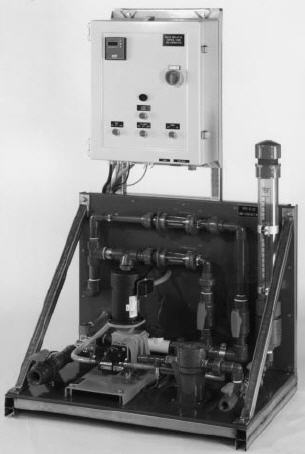Water Chemicals
Oxygen Scavengers
Sulfites – typically for boilers up to 800 psi; sulfites react with oxygen to form sulfates that are removed from the boiler via blowdown. There are two forms of sulfite: Catalyzed – uses a catalyst to improve reaction time; Non-catalyzed – slower reaction time and must be used in hot water
Hydrazine – typically for boilers over 800 psi. At pressure higher than 800 psi, sulfite begins to break down into acidic gases of sulfur. Sulfite also creates additional Total Dissolved Solids (TDS) which is a problem for high pressure applications. Hydrazine removes O2 without producing acidic gases or TDS, but is considered a possible carcinogen.
Hydroxides
Sodium Hydroxide – NaOH or Caustic Soda, or Soda Ash – used to maintain boiler water pH in the 10.0 – 11.5 range. Hydroxide increase boiler alkalinity to prevent acidic corrosion. If heavy scale is present, caustic soda can accumulate to cause Caustic Attack. See pH Treatment
Calcium-Hydroxide – reacts with calcium and magnesium bicarbonates to form sludge that is removed via blowdown.
Phosphates
Phosphate treatment causes calcium and magnesium to precipitate into sludge where it can be removed via blowdown.
Polymers
Polymers are long, complex molecules that attach to impurities and prevent them from sticking to boiler metal to form scale. This creates TDS that are removed via blowdown.
Chelants
Chelants can prevent scale from forming and over time, remove existing scale. Chelants in contact with 02 is corrosive. It must therefore be used in an 02- free environment.
Neutralizing Amines
Neutralizing amines hydrolyze in water to generate the necessary hydroxide ions required for neutralization of the carbon dioxide. The normal approach to treating systems with these amines is to feed sufficient quantity to neutralize the carbon dioxide and then provide small additional amounts to buffer the pH to 8.5 or 9.0. At this pH, continued preservation of the magnetite film (boiler metal) is also achieved. It is also implied that corrosion will not exist at a pH>8.0-8.5.
Filming Amines
Filming amines function by forming a protective barrier against both oxygen and carbon dioxide attack. These amines form films directly with the condensate line metal and develop a barrier to prevent contact of the corrosive condensate with the return piping. By design, film formers have been developed to function best at a pH of 5.5-7.5. In addition, these amines are highly surface-active and will slough loosely adherent iron oxide and other corrosion products back to receiving points or to the boiler. Care must be exercised with the feed of filming amines.
Combination Amines. Over the past several years, combinations of filming and neutralizing amines have been shown to be extremely effective, particularly in complex systems. While the combination amine is still functionally a filmer, the neutralizing amine portions provide for reduction in fouling potential and more uniform coverage of the filmer.
Filming amines and combination amines are generally fed to steam headers. Dosages are based on steam production.
More Information
Manufacturers and Suppliers
 Nalco Company
Nalco Company
1601 W. Diehl Road
Naperville, IL 60563-1198
Telephone: 877-813-3523
Fax: 630-305-2900
Go to their web site atwww.nalco.com
